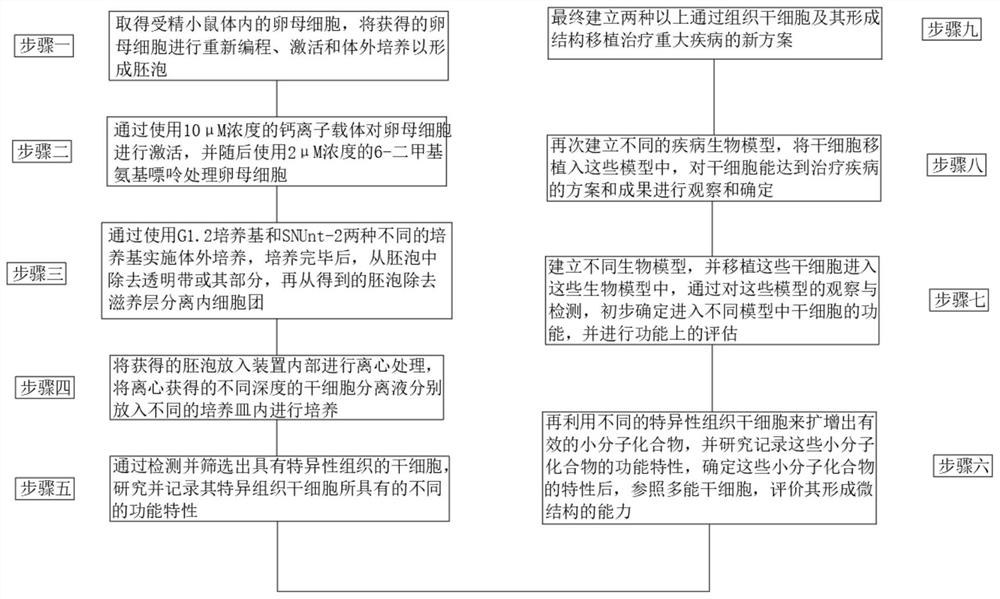Tissue stem cell separation and function evaluation system
A technology for evaluating systems and stem cells, which is applied in the field of stem cell separation, and can solve problems such as the separation liquid is not pure enough, error-prone, and the operating environment is uncontrolled
- Summary
- Abstract
- Description
- Claims
- Application Information
AI Technical Summary
Problems solved by technology
Method used
Image
Examples
Embodiment 1
[0042] A tissue stem cell isolation and functional evaluation system, comprising the following steps:
[0043] Step 1: Put male mice and female mice together to mate, rest the fertilized female mice for a few days, obtain oocytes from the fertilized mice, reprogram, activate and culture the obtained oocytes in vitro Blastocyst formation;
[0044] Step 2: activating the oocytes by using a calcium ionophore at a concentration of 5 μM-15 μM, and then treating the oocytes with 6-dimethylaminopurine at a concentration of 1 μM-5 μM;
[0045] Step 3: Carry out in vitro culture by using two different mediums of G1.2 medium and SNUnt-2. After the culture is completed, remove the zona pellucida or part thereof from the blastocyst, and then remove the trophoblast from the obtained blastocyst to separate the inner cell mass;
[0046] Step 4: Put the obtained blastocysts into the centrifugal device for centrifugation, and put the stem cell separation fluids obtained by centrifugation at di...
Embodiment 3
[0058] A tissue stem cell isolation and functional evaluation system, comprising the following steps:
[0059] Step 1: Put male mice and female mice together to mate, rest the fertilized female mice for a few days, obtain oocytes from the fertilized mice, reprogram, activate and culture the obtained oocytes in vitro Blastocyst formation;
[0060] Step 2: activating the oocytes by using a calcium ionophore at a concentration of 5 μM-15 μM, and then treating the oocytes with 6-dimethylaminopurine at a concentration of 1 μM-5 μM;
[0061] Step 3: Carry out in vitro culture by using two different mediums of G1.2 medium and SNUnt-2. After the culture is completed, remove the zona pellucida or part thereof from the blastocyst, and then remove the trophoblast from the obtained blastocyst to separate the inner cell mass;
[0062] Step 4: Put the obtained blastocysts into the centrifugal device for centrifugation, and put the stem cell separation fluids obtained by centrifugation at ...
Embodiment 4
[0074] A tissue stem cell isolation and functional evaluation system, comprising the following steps:
[0075] Step 1: Put male mice and female mice together to mate, rest the fertilized female mice for a few days, obtain oocytes from the fertilized mice, reprogram, activate and culture the obtained oocytes in vitro Blastocyst formation;
[0076] Step 2: activating the oocytes by using a calcium ionophore at a concentration of 5 μM-15 μM, and then treating the oocytes with 6-dimethylaminopurine at a concentration of 1 μM-5 μM;
[0077] Step 3: Carry out in vitro culture by using two different mediums of G1.2 medium and SNUnt-2. After the culture is completed, remove the zona pellucida or part thereof from the blastocyst, and then remove the trophoblast from the obtained blastocyst to separate the inner cell mass;
[0078] Step 4: Put the obtained blastocysts into the centrifugal device for centrifugation, and put the stem cell separation fluids obtained by centrifugation at ...
PUM
 Login to View More
Login to View More Abstract
Description
Claims
Application Information
 Login to View More
Login to View More - R&D
- Intellectual Property
- Life Sciences
- Materials
- Tech Scout
- Unparalleled Data Quality
- Higher Quality Content
- 60% Fewer Hallucinations
Browse by: Latest US Patents, China's latest patents, Technical Efficacy Thesaurus, Application Domain, Technology Topic, Popular Technical Reports.
© 2025 PatSnap. All rights reserved.Legal|Privacy policy|Modern Slavery Act Transparency Statement|Sitemap|About US| Contact US: help@patsnap.com

